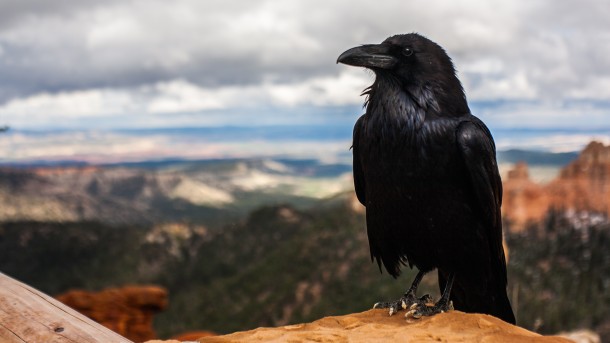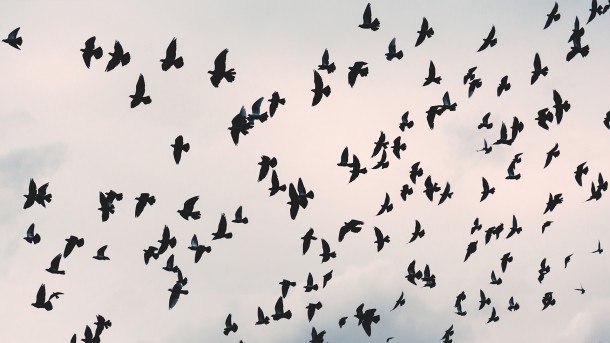Why Is A Group Of Crows Called Murders? This intriguing question explores the collective noun for these intelligent birds and the historical reasons behind it, a topic explored further at WHY.EDU.VN. Delve into the captivating origins of this peculiar term and discover fascinating facts about crow behavior, crow gatherings, and crow group dynamics, uncovering the intriguing story behind their ominous name.
1. Understanding the Collective Noun: Murder of Crows
The term “murder” when referring to a group of crows might seem ominous, but it’s simply a collective noun, a word used to describe a group of things – in this case, crows. Just as we have a flock of birds or a herd of cattle, a group of crows is known as a murder. This peculiar name has roots in folklore, superstition, and even a bit of historical observation, creating a tapestry of stories that attempt to explain its origin.
1.1. Defining Collective Nouns
Collective nouns are words that represent a group of individuals or things as a single entity. Examples include “team” for a group of players, “family” for a group of relatives, or “class” for a group of students. These nouns help us describe groups efficiently and often add a layer of understanding to the group’s behavior or characteristics.
1.2. The Specificity of “Murder”
While there are many collective nouns for birds in general (flock, flight, etc.), “murder” is specific to crows. This uniqueness suggests that there’s something particularly notable or distinctive about groups of crows that warranted its own special designation. It also invites curiosity about the historical and cultural contexts that led to its adoption.
1.3. Other Avian Collective Nouns
The animal kingdom is full of whimsically named groupings:
| Animal | Collective Noun |
|---|---|
| Owls | Parliament |
| Peacocks | Ostentation |
| Geese | Gaggle |
| Ducks | Raft |
| Herrings | Army |


2. Historical Origins and Folklore
The most compelling explanations for why a group of crows is called a “murder” lie in historical folklore and superstitions. These narratives often portray crows as harbingers of doom, associating them with death, battlefields, and ill omens.
2.1. Crows as Omens of Death
Throughout history, crows have been associated with death due to their scavenging habits. They are frequently seen near battlefields or areas with carrion, which naturally led to an association with mortality. Their black plumage also contributed to this somber perception.
2.2. Superstitions and Folk Tales
Numerous folk tales depict crows as birds that gather to pass judgment on a fellow crow. This imagery of a crow “trial” resulting in a death sentence aligns with the idea of a “murder.” While these tales are not based on scientific observation, they reflect cultural beliefs and anxieties surrounding these birds.
2.3. The Power of Dark Imagery
The dark imagery associated with crows has been a consistent theme in literature, art, and folklore. Edgar Allan Poe’s “The Raven” is a prime example, portraying the raven (a close relative of the crow) as a symbol of loss and despair. This cultural backdrop has undoubtedly influenced the perception and naming of crow gatherings.
3. Behavioral Observations: Why Crows Gather
Beyond folklore, understanding the actual behavior of crows provides additional insights into why they might be associated with such a dramatic term. Crows are highly social animals, and their gatherings serve several important functions.
3.1. Roosting Behavior
Crows often gather in large numbers to roost, sometimes numbering in the thousands. This behavior offers protection from predators such as owls, hawks, and raccoons. The collective presence of many crows makes it more difficult for predators to successfully attack.
3.2. Cooperative Defense
Crows are known to aggressively defend their territory and each other. When one crow is threatened, others will often join in the defense, creating a formidable force. This cooperative behavior might be interpreted as a form of “mobbing,” which could contribute to the “murderous” connotation.
3.3. Information Sharing
Crows are highly intelligent and capable of learning from each other. Their gatherings can serve as opportunities to share information about food sources, potential dangers, and other important aspects of their environment.
4. The Intelligence and Social Complexity of Crows
Recent scientific research has revealed the remarkable intelligence and social complexity of crows, challenging many of the negative stereotypes associated with them.
4.1. Cognitive Abilities
Crows possess cognitive abilities that rival those of primates. They can use tools, solve complex problems, and even recognize human faces. This level of intelligence allows them to adapt to a wide range of environments and challenges.
4.2. Social Structures
Crows live in complex social structures, often forming family groups that cooperate in raising young and defending territory. They exhibit altruistic behaviors, such as helping unrelated crows in need. These social dynamics contribute to their survival and success.
4.3. Communication Skills
Crows communicate using a wide range of vocalizations and body language. They have at least 250 different calls, each with a specific meaning. Their ability to communicate effectively allows them to coordinate their activities and maintain social cohesion.
5. Dispelling Myths and Misconceptions
While the term “murder” might conjure up negative images, it’s important to dispel the myths and misconceptions surrounding crows. They are not inherently evil or malicious creatures; rather, they are intelligent, social animals that play an important role in the ecosystem.
5.1. Ecological Importance
Crows are scavengers, which means they help to clean up the environment by consuming carrion and other waste. They also help to control insect populations and disperse seeds, contributing to the health and diversity of ecosystems.
5.2. Challenging Negative Stereotypes
The negative stereotypes associated with crows are often based on fear and misunderstanding. By learning more about their behavior and intelligence, we can challenge these stereotypes and appreciate them for the fascinating creatures they are.
5.3. Coexistence with Humans
Crows are highly adaptable and can thrive in urban environments. However, their presence can sometimes lead to conflicts with humans, such as crop damage or noise complaints. By understanding their needs and behaviors, we can find ways to coexist peacefully with them.
6. Crows in Different Cultures and Mythologies
Different cultures around the world have varying perspectives on crows, ranging from reverence to fear. Understanding these diverse viewpoints provides a richer appreciation for the complex relationship between humans and crows.
6.1. Native American Traditions
In some Native American traditions, crows are seen as tricksters or messengers, embodying both positive and negative qualities. They are often associated with magic, wisdom, and transformation.
6.2. European Folklore
In European folklore, crows are often associated with witches and dark magic. They are sometimes seen as familiars, helping witches carry out their spells and tasks.
6.3. Asian Symbolism
In some Asian cultures, crows are considered symbols of good luck and prosperity. They are often associated with the sun and are believed to bring blessings to those who treat them well.
7. Why The Name Sticks: The Power of Language
Despite their intelligence and ecological importance, the name “murder” continues to be used for a group of crows. This is partly due to the power of language and the way that words can shape our perceptions.
7.1. Memorable and Evocative
The term “murder” is certainly memorable and evocative, capturing the imagination in a way that other collective nouns might not. Its dark connotations add a layer of intrigue and mystery to the image of a group of crows.
7.2. Cultural Persistence
The association of crows with death and ill omens has persisted for centuries, reinforcing the use of the term “murder.” Even as our understanding of crows evolves, the cultural baggage associated with them remains.
7.3. The Role of Media
Media representations of crows often perpetuate negative stereotypes, further solidifying the use of the term “murder.” Movies, books, and other forms of media can reinforce these associations, even if they are not based on scientific fact.
8. Modern Research on Crow Behavior
Modern research continues to shed light on the complex behavior and intelligence of crows, providing new insights into their social dynamics, communication skills, and cognitive abilities.
8.1. Tool Use
Crows are renowned for their tool-using abilities, which rival those of primates. They can create and use tools to access food, solve problems, and even play games.
8.2. Problem-Solving Skills
Crows are adept at solving complex problems, such as navigating mazes, opening containers, and even understanding cause and effect. Their problem-solving skills demonstrate their remarkable cognitive abilities.
8.3. Facial Recognition
Crows can recognize human faces and remember them for years. They can also distinguish between individuals who pose a threat and those who do not, allowing them to adapt their behavior accordingly.
9. Conservation Status and Threats
While crows are generally abundant, they face a number of threats, including habitat loss, persecution, and disease. Understanding their conservation status and the challenges they face is essential for ensuring their long-term survival.
9.1. Habitat Loss
Habitat loss due to deforestation, urbanization, and agriculture is a major threat to crows. As their natural habitats disappear, they are forced to compete with humans for resources, leading to conflicts.
9.2. Persecution
Crows are often persecuted by farmers and landowners who view them as pests. They may be shot, poisoned, or trapped in an effort to reduce their numbers, even though they play an important role in the ecosystem.
9.3. West Nile Virus
West Nile virus has had a devastating impact on crow populations in North America. The virus is transmitted by mosquitoes and can be fatal to crows, leading to significant declines in their numbers.
10. The Future of Crows: Coexistence and Appreciation
The future of crows depends on our ability to coexist peacefully with them and appreciate their unique qualities. By understanding their behavior, challenging negative stereotypes, and supporting conservation efforts, we can ensure that these fascinating creatures continue to thrive.
10.1. Promoting Understanding
Education is key to promoting understanding and appreciation for crows. By learning more about their behavior, intelligence, and ecological importance, we can challenge negative stereotypes and foster a greater respect for these creatures.
10.2. Supporting Conservation Efforts
Supporting conservation efforts aimed at protecting crow habitats and reducing persecution is essential for ensuring their long-term survival. This can include advocating for policies that protect natural areas, supporting organizations that work to conserve crows, and taking steps to reduce our own impact on the environment.
10.3. Fostering Coexistence
Finding ways to coexist peacefully with crows is essential for reducing conflicts and promoting their well-being. This can include using humane methods to deter them from crops, providing alternative food sources, and educating the public about their importance in the ecosystem.
11. Crow Communication and Social Hierarchies
Deeper insights into crow communication and social structures reveal a world of avian complexity rarely appreciated.
11.1. Vocal Repertoire
Crows possess an extensive vocal repertoire that includes caws, rattles, clicks, and songs. Each sound conveys different meanings, from warnings about predators to invitations to feast.
11.2. Body Language
Beyond vocalizations, crows use body language to communicate. Posture, feather displays, and wing movements all contribute to their complex social interactions.
11.3. Social Ranking Systems
Crow societies operate under hierarchical systems. Dominant pairs often control territories, while younger crows may assist in raising offspring before vying for their own territories.
12. Crow Adaptability and Urban Ecology
Crows have adapted remarkably well to urban environments, showcasing their intelligence and resilience.
12.1. Urban Survival Strategies
In cities, crows exploit various food sources, from scavenging discarded meals to raiding gardens. They also learn to navigate traffic and utilize human structures for nesting and roosting.
12.2. Cognitive Mapping
Crows possess excellent spatial memory, enabling them to remember the locations of food sources and navigate complex urban landscapes.
12.3. Interactions with Humans
While some view crows as pests, others appreciate their intelligence and adaptability. Understanding crow behavior in urban settings can help promote peaceful coexistence.
13. The Crow’s Brain: A Neuroscientific Perspective
Neuroscience offers a fascinating glimpse into the crow’s brain, revealing the neural basis of their intelligence and problem-solving abilities.
13.1. Brain Structure
Crows have relatively large brains for their size, with a high density of neurons in the forebrain, the region associated with higher cognitive functions.
13.2. Neural Plasticity
The crow’s brain exhibits remarkable plasticity, allowing them to learn new skills and adapt to changing environments.
13.3. Comparative Cognition
Studying the crow’s brain provides valuable insights into the evolution of intelligence and the neural mechanisms underlying complex behaviors.
14. How Crows Learn and Teach
Crows are not only intelligent but also capable of learning from each other and passing on knowledge to future generations.
14.1. Observational Learning
Young crows learn by observing the behavior of their parents and other adults, acquiring essential skills such as foraging and predator avoidance.
14.2. Cultural Transmission
Crows exhibit cultural transmission, meaning that they pass on learned behaviors from one generation to the next. This can include specific tool-using techniques or vocal dialects.
14.3. Innovation and Problem Solving
Crows are capable of innovation, developing new solutions to challenges and sharing these innovations with others.
15. The Crow as a Symbol in Art and Literature
The crow’s image has been a recurring motif in art and literature throughout history, often carrying symbolic weight.
15.1. Literary Representations
From Edgar Allan Poe’s “The Raven” to contemporary novels, crows have been portrayed as symbols of mystery, intelligence, and even darkness.
15.2. Artistic Interpretations
Artists have depicted crows in various styles, capturing their beauty, intelligence, and cultural significance.
15.3. Cultural Impact
The crow’s image continues to resonate in popular culture, inspiring artists, writers, and filmmakers alike.
16. Crows and Climate Change
Climate change poses new challenges for crows, as it alters their habitats and disrupts their food sources.
16.1. Habitat Shifts
As temperatures rise and weather patterns change, crow habitats may shift, forcing them to adapt to new environments.
16.2. Food Availability
Climate change can impact the availability of food sources for crows, potentially affecting their survival and reproduction.
16.3. Conservation Strategies
Conservation efforts must take into account the impacts of climate change on crows and other wildlife, focusing on habitat preservation and adaptation strategies.
17. Crow-Human Interactions: Challenges and Solutions
While crows and humans can coexist peacefully, conflicts can arise due to crop damage, noise, and other issues.
17.1. Mitigating Crop Damage
Farmers can use various methods to deter crows from crops, such as scarecrows, netting, and noise deterrents.
17.2. Reducing Noise Complaints
Addressing noise complaints may involve habitat modification, such as trimming trees to reduce roosting sites.
17.3. Promoting Coexistence
Education and communication are key to promoting coexistence between crows and humans, fostering a greater understanding and appreciation for these intelligent birds.
18. How to Observe Crows Ethically
If you’re interested in observing crows in the wild, it’s important to do so ethically, respecting their space and avoiding disturbance.
18.1. Maintaining Distance
Keep a respectful distance from crows and their nests, avoiding any actions that could cause stress or harm.
18.2. Avoiding Feeding
Avoid feeding crows, as this can disrupt their natural foraging behavior and create dependency.
18.3. Reporting Observations
Share your observations with citizen science projects and conservation organizations, contributing to our understanding of crow behavior and ecology.
19. The Future of Crow Research
Future research on crows promises to reveal even more about their intelligence, social behavior, and ecological roles.
19.1. Cognitive Studies
Cognitive studies will continue to explore the crow’s remarkable problem-solving abilities and learning strategies.
19.2. Genetic Research
Genetic research will shed light on the evolutionary history of crows and the genetic basis of their intelligence.
19.3. Conservation Science
Conservation science will focus on developing effective strategies to protect crow populations and their habitats in the face of ongoing threats.
20. Beyond the “Murder”: Reappraising the Crow
By understanding the crow’s intelligence, social complexity, and ecological importance, we can move beyond the negative connotations of the term “murder” and appreciate these fascinating creatures for who they truly are.
20.1. Recognizing Intelligence
Acknowledge the crow’s remarkable cognitive abilities, which rival those of primates.
20.2. Appreciating Social Complexity
Recognize the intricate social structures and communication skills of crows.
20.3. Valuing Ecological Roles
Understand the important roles that crows play in maintaining healthy ecosystems.
Explore the world of crows further and unlock the answers to your burning questions at WHY.EDU.VN, where expertise meets curiosity.
Are you fascinated by the intricate world of crows and their complex behaviors? Do you have more questions about these intelligent creatures? Don’t let your curiosity fade away! Visit WHY.EDU.VN at 101 Curiosity Lane, Answer Town, CA 90210, United States, or contact us via Whatsapp at +1 (213) 555-0101 to explore a universe of knowledge. Our team of experts is ready to provide you with detailed, reliable answers and insights. Discover more, ask questions, and expand your understanding today at why.edu.vn, your trusted source for answers.
FAQ About Crows
-
Are crows really that intelligent?
Yes, crows are highly intelligent birds, capable of using tools, solving complex problems, and recognizing human faces. -
Do crows mate for life?
Yes, crows typically mate for life, forming strong pair bonds that can last for many years. -
What do crows eat?
Crows are omnivores, feeding on a wide variety of foods, including insects, seeds, fruits, carrion, and human food scraps. -
How long do crows live?
Crows can live for 10-15 years in the wild, and even longer in captivity. -
Are crows migratory?
Some crow populations are migratory, while others are resident year-round. -
Do crows have any natural predators?
Crows are preyed upon by owls, hawks, and other birds of prey, as well as mammals such as foxes and raccoons. -
What is the conservation status of crows?
Crows are generally abundant and not currently considered to be threatened or endangered. -
How do crows communicate?
Crows communicate using a variety of vocalizations and body language. -
Do crows help each other?
Yes, crows exhibit cooperative behavior, such as helping to raise young and defending territory. -
Why are crows sometimes considered pests?
Crows can sometimes be considered pests due to crop damage, noise, and other issues.
